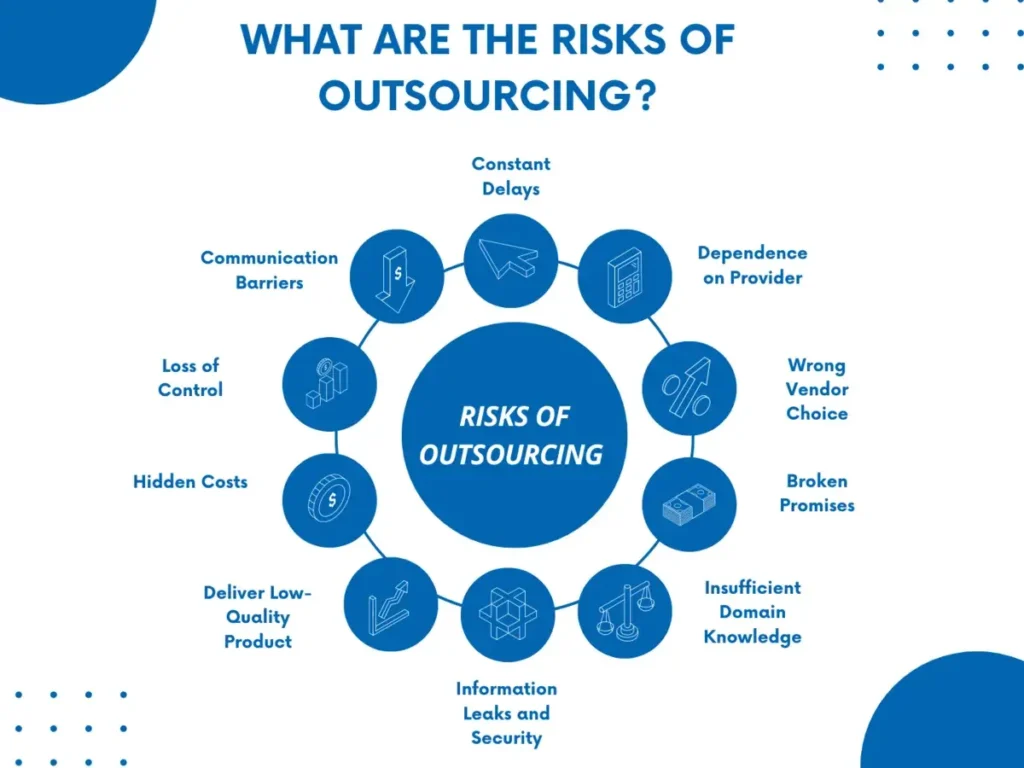
Outsourcing is an integral part of modern businesses and 90% of firms believe that outsourcing is crucial to their growth strategies. It is a useful component of corporate strategy that reduces expenses, solves capability issues, boosts productivity, and brings innovations. However, there are some risks associated with it that companies need to consider and navigate.
So, in this blog, you get complete information that covers what outsourcing is and highlights the risks of outsourcing your business to service providers.
What is Outsourcing?
Outsourcing is a method of hiring a third-party service provider that manages operations of your business that is normally done by an in-house team. The main motivations behind outsourcing are the need to cut expenses, and access technologies and expertise that are not available internally.
The main purpose of outsourcing is to:
- Help organizations to save costs associated with managing their IT infrastructure and operations.
- Help you access a global talent pool and improve team efficiency through outside expertise.
- Help you scale your operations up or down as needed without making a long-term commitment.
- Allows you to keep your focus on the core business.
Moreover, outsourcing has three main types:
1. Onshore Outsourcing
Onshore outsourcing refers to the practice of contracting work to a third-party provider within the same country as the hiring organization. This allows companies to take advantage of cost savings, specialized expertise, and improved efficiency while maintaining proximity and cultural alignment with the outsourced provider.
2. Offshore Outsourcing
Offshore outsourcing involves contracting work to a third-party provider located in a different country, often one with lower labor costs and a skilled workforce. This can provide significant cost savings, access to a large talent pool, and the ability to operate 24/7. However, it may also introduce challenges related to time zone differences, cultural barriers, and communication challenges.
3. Nearshore Outsourcing
Nearshore outsourcing is a hybrid approach that involves contracting work to a third-party provider in a neighboring or nearby country. This can offer a balance between the cost savings of offshore outsourcing and the proximity and cultural similarities of onshore outsourcing. Nearshore outsourcing often allows for easier collaboration, better communication, and faster response times compared to offshore outsourcing.
The choice between these three types of outsourcing depends on your business needs.
What Are The Risks of Outsourcing?
It’s no secret that outsourcing is a game-changer for startups and big corporations to accomplish their goals cost-effectively. With outsourcing, businesses can easily expand their market reach and grow rapidly.
However, making a move into the outsourcing sector without a thorough grasp of the risks involved can lead to failures rather than advancements.
Below are the top ten risks of outsourcing that businesses face.

1. Communication Barriers
The primary risk of outsourcing is the lack of communication between the business and the service provider. A lack of clear, consistent communication can lead to misunderstandings, mistakes, and inefficiencies.
The main challenges that are faced due to communication barriers are:
- Language limitations can lead to misunderstandings that impact the performance and clarity of a project.
- Time zone differences might cause coordination issues and longer response times.
- The absence of in-person interactions can make it more difficult to establish clear communication and build stronger interpersonal relationships between the client and the outsourcing team.
- Reliance on remote communication technologies can be hindered by technical issues, network reliability, and differences in technological capabilities between the client and outsourcing provider.
Furthermore, below are some ways that help you mitigate this outsourcing risk.
- Set standardized formats for communication.
- Use effective tools for communication.
- Set business hours.
2. Loss of Control
It is another big outsourcing risk. You give up some control over specific areas when you assign tasks or services to an outsourcing partner. This might affect how certain jobs are finished in terms of quality, timeliness, or technique.
To overcome this risk, follow these strategies that make your outsourcing arrangement effective.
- Follow up with the outsourced provider regularly to make sure the project’s requirements are being met.
- Make sure that the agreement you have with the outsourced company is clear. This should include all the details of the work and expectations for quality and timeliness.
- Have a backup plan in case the contracted firm is unable to satisfy your requirements.
3. Hidden Costs
The main motive behind outsourcing is to gain a competitive advantage through cost savings and improved profitability. However, if outsourcing results in unforeseen and hidden costs, it can become a significant risk rather than an advantage.
The key is to carefully evaluate all potential hidden costs associated with outsourcing. Some of the main hidden costs that can undermine the expected cost savings include:
- Increased coordination and management expenses
- Training and knowledge transfer costs
- Intellectual property risks
- Cultural integration challenges
- Unexpected transition expenses
- Decreased operational flexibility
If these hidden costs are not properly anticipated and managed, they can quickly erode the anticipated cost savings and profitability gains that companies hope to achieve through outsourcing. This can ultimately negate the competitive advantage that outsourcing was meant to provide.
4. Deliver Low-Quality Product
With outsourcing, businesses need to save money and focus on their core competencies. However, there are risks associated with outsourcing teams as well, such as the possibility of delivering poor-quality work.
Businesses trust the other company to deliver a high standard of service similar to them when they get into a contract with it. Therefore, businesses need to be careful when choosing outsourcing providers to minimize these risks. To ensure they are making a wise investment, businesses need to thoroughly examine the contractor’s track record and reputation.
Launch Your SaaS Product with NinjasCode
5. Information Leaks and Security
The main risks with outsourcing are privacy and security concerns. All of the hazards are ultimately caused by selecting the incorrect outsourcing provider.
When a company outsources its operations, they have completely or partially exposes its business assets to an outsider. This includes confidential information such as financial data, customer records, etc.
To avoid the risk of losing your information, you have to take these steps:
- Ensure the outsourcing provider has robust security procedures and protocols in place to protect sensitive data.
- Assess their track record, certifications, and adherence to industry security standards.
- Regularly audit the security practices of the outsourcing partner.
- Establish clear protocols for data handling, storage, and retrieval.
- It’s critical to have a Non-Disclosure Agreement in writing so that all parties are aware of the terms and conditions of security and privacy.
6. Insufficient Domain Knowledge
Lack of domain knowledge is another main outsourcing software development risk. This can create problems such as failure to understand the client’s requirements and the lack of dedication to the project.
To avoid this problem, always work with an experienced outsourcing service provider that understands your business needs and delivers the work according to your requirements.
7. Broken Promises
Many outsourcing providers are honest and upfront with their clients. However, some do not live up to their promises, leading to what can be called “broken promises” in the outsourcing relationship.
Some of the common ways in which outsourcing providers may break promises include:
- Overstating their technical expertise, industry experience, or ability to deliver on the client’s requirements.
- Failing to disclose limitations or shortcomings in their service offerings.
- Providing work that does not meet the agreed-upon quality standards.
- Using substandard resources to save costs.
- Failing to meet the promised delivery timelines and milestones.
- Hiding important information or failing to provide visibility into the outsourcing process.
- Introducing additional or hidden fees that were not part of the original agreement.
To mitigate the risks of broken promises, it is crucial for organizations to:
- Conduct thorough research on potential outsourcing partners.
- Clearly define expectations, service levels, and contractual obligations.
- Establish open communication and actively monitor the activities.
By taking these proactive steps, companies can better protect themselves from the risks of broken promises and ensure a successful and reliable outsourcing partnership.
8. Wrong Vendor Choice
Selecting the wrong vendor is one of the main outsourcing risks. The wrong provider who doesn’t have the necessary skills, resources, and experience will pose numerous risks. You will always get poor-quality work that doesn’t meet your requirements.
Almost 50% of businesses end their outsourcing relationships due to performance issues, according to the 2022 Global Software Outsourcing Trends and Rates.
To mitigate the risks of selecting the wrong outsourcing vendor, organizations should:
- Clearly define the required skills, resources, and capabilities upfront.
- Prioritize vendor experience, references, and proven track record.
- Establish strict service-level agreements and performance metrics.
- Maintain monitoring of the vendor’s performance.
9. Dependence on Provider
Outsourcing can provide significant benefits, but relying too heavily on an outsourcing partner can also become a risk in itself. As the organization becomes highly dependent on the outsourcing provider, it may lose direct control over critical business processes and operations.
When an organization outsources core competencies, it may lose the ability to innovate and differentiate itself in the market. This can hinder the organization’s long-term competitiveness and adaptability to changing market conditions.
To mitigate the risks of over-reliance on an outsourcing partner, organizations should:
- Maintain a balanced portfolio of in-house and outsourced capabilities.
- Regularly review and optimize the scope of outsourced work.
- Develop contingency plans and exit strategies for outsourcing arrangements.
10. Constant Delays
The constant delays can significantly damage your project’s reputation and implementation. This issue arises when the outsourcing provider doesn’t have efficient tools to handle the project appropriately or your company has a new demand for them.
Moreover, inaccurate estimates and a failure to list all of the crucial project needs might cause delays. It may also impact the project’s overall success.
The solution to overcome this type of outsourcing risk involves some steps, such as:
- Assess the provider’s project management capabilities, tools, and past performance.
- Ensure they have the necessary resources and expertise to handle the project’s scope and timeline.
- Clearly define and document all project requirements, deliverables, and milestones.
- Establish realistic timelines and build buffer time to accommodate potential changes.
- Implement regular progress reviews, status updates, and open communication channels.
- Establish clear channels to address issues and delays proactively.
- Adopt an agile approach to accommodate changes and address delays promptly.
Positive and Negative Effects of Outsourcing
The below table shows the positive and negative effects of outsourcing.
| Pros of Outsourcing | Cons of Outsourcing |
| Access to specialized skills and expertise | Security risks |
| Lower labor costs | Lack of dedication |
| Faster turnaround time | Continuously monitor performance |
| Easily focus on core operations | Potential for errors |
| Scalability and flexibility | Hidden charges |
| Improve productivity and efficiency | Lack of expertise |
| Save time and resources | Poor communication leads to poor product quality |
| You can work around the clock |
How Do You Mitigate Outsourcing Risks?
Careful planning and ongoing monitoring are essential to avoid outsourcing becoming a risk rather than an advantage.
Here are some ways to help you minimize the risks of outsourcing.
- Clearly define the specific business objectives, functions, and processes that will be outsourced.
- Research and evaluate potential outsourcing providers thoroughly, considering their capabilities, expertise, financial stability, and security measures.
- Conduct site visits, reference checks, and in-depth assessments to ensure the vendor is the right fit.
- Implement regular performance reviews and audits to monitor the provider’s delivery and address any issues.
- Retain critical in-house skills and expertise to ensure the organization can effectively manage the outsourcing relationship.
- Provide ongoing training and development to keep internal teams up-to-date on the outsourced work.
- Develop comprehensive transition plans to onboard the outsourcing provider smoothly and minimize disruptions.
- Establish clear exit strategies and contingency plans in case the outsourcing relationship needs to be terminated.
- Promote open communication, trust, and a shared understanding of goals with the outsourcing provider.
- Encourage a collaborative approach to problem-solving and continuous improvement.
Conclusion
With the help of outsourcing, companies can get their work done efficiently and quickly at a lower cost. However, like anything else, there are risks associated with it. All you have to do is follow the steps that are mentioned above to help you work with an outsourcing provider hassle-free.
So, do you want to save time, money, and resources for your business with a top-notch outsourcing provider? Schedule a meeting with us and our sales team to help you outsource your next project.
FAQs
- What are the risks of outsourcing software?
Below are some risks of outsourcing software.
- Compliance issues
- Data loss
- Loss of control
- Risk management
- Quality control issues
- What is the negative impact of outsourcing?
The negative impacts of outsourcing can include:
- Loss of control over critical business functions
- Reduced job opportunities for local workers
- Potential security and data privacy issues
- What are the future challenges of outsourcing?
The future challenges of outsourcing are:
- Managing the impact of automation and AI on outsourced roles.
- Maintaining the right balance between in-house capabilities and outsourced functions as business needs evolve.







